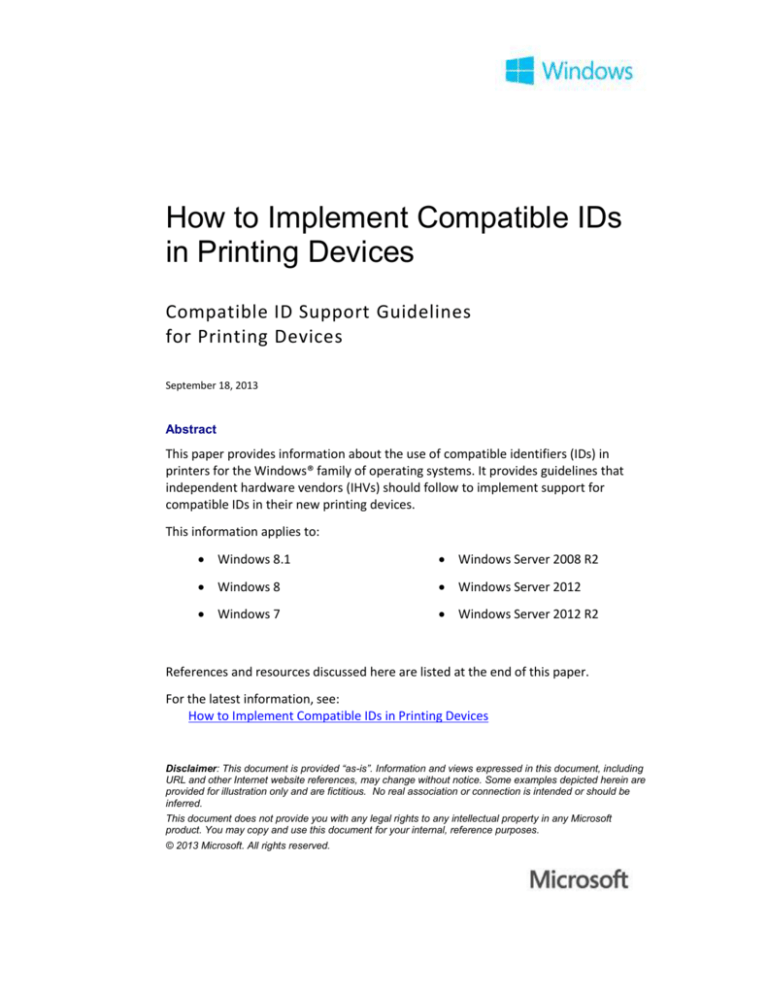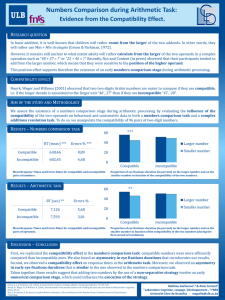
How to Implement Compatible IDs
in Printing Devices
Compatible ID Support Guidelines
for Printing Devices
September 18, 2013
Abstract
This paper provides information about the use of compatible identifiers (IDs) in
printers for the Windows® family of operating systems. It provides guidelines that
independent hardware vendors (IHVs) should follow to implement support for
compatible IDs in their new printing devices.
This information applies to:
Windows 8.1
Windows Server 2008 R2
Windows 8
Windows Server 2012
Windows 7
Windows Server 2012 R2
References and resources discussed here are listed at the end of this paper.
For the latest information, see:
How to Implement Compatible IDs in Printing Devices
Disclaimer: This document is provided “as-is”. Information and views expressed in this document, including
URL and other Internet website references, may change without notice. Some examples depicted herein are
provided for illustration only and are fictitious. No real association or connection is intended or should be
inferred.
This document does not provide you with any legal rights to any intellectual property in any Microsoft
product. You may copy and use this document for your internal, reference purposes.
© 2013 Microsoft. All rights reserved.
How to Implement Compatible IDs in Printing Devices - 2
Document History
Date
January 20, 2009
April 18, 2013
September 18, 2013
Change
First publication
Update to compatible ID character selection
Update to Updating the Printer Device’s INF File section
Contents
Overview ........................................................................................................................ 3
Choosing a Compatible ID .............................................................................................. 3
Updating the Printer’s Firmware.................................................................................... 4
Updating the Printing Device’s INF File .......................................................................... 5
Resources ....................................................................................................................... 7
September 18, 2013
© 2013 Microsoft Corporation. All rights reserved.
How to Implement Compatible IDs in Printing Devices - 3
Overview
In Windows® 7, the parsing of IEEE 1284 identifier (ID) strings that are reported by
printing devices has expanded to include compatible IDs. Compatible IDs let
independent hardware vendors (IHVs) specify a generic ID for a family or class of
devices that a single driver supports. This does not affect or change the existing
hardware ID that is generated for printers. Therefore, legacy printing devices and
drivers continue to function correctly.
Device manufacturers can categorize new printing devices through a single
compatible ID and associate devices generically to a single driver without a specific
hardware ID match. This lets device manufacturers ship a driver package that will
continue to support devices that have not yet been developed, without requiring an
update to the package’s information (INF) file.
For more information about compatible IDs and hardware IDs, see Device
Identification Strings.
Choosing a Compatible ID
Construct a compatible ID by using the following guidelines, which are explained in
detail later in this paper. This section provides a summary of these guidelines:
The compatible ID should always start with the name of the organization that
defines the compatible ID. This helps ensure that no collisions occur between
values from different companies. For example, any compatible ID that is defined
by a company named Contoso would start with “Contoso”.
The compatible ID must contain only the following ASCII characters:
Lowercase alphabetical characters (a through z)
Uppercase alphabetical characters (A through Z)
Numeric characters (0 through 9)
Underscores, dots and dashes
Any leading or trailing white space is ignored and should not be considered part
of the compatible ID.
White space in between characters in a compatible ID must not be used to avoid
potential mismatching. Please note that all white space in compatible ID (except
leading/trailing) will be converted to underscores during enumeration.
The compatible ID must not exceed 180 characters long.
The compatible ID should be chosen to represent a family or class of devices that
can all be used with the same driver. Generally, printing devices should be
assigned the same compatible ID if:
They use the same driver.
They are managed by the same application or service that the IHV developed.
They use the same print processors and color profiles.
Any functional differences between printing devices can be resolved by the
driver during device installation or ordinary operation.
September 18, 2013
© 2013 Microsoft Corporation. All rights reserved.
How to Implement Compatible IDs in Printing Devices - 4
Follow the last guideline to minimize the number of compatible IDs that are required
to support your printing devices and to maximize the functionality that the driver
exposes for the devices that it supports. For example, if you introduce a new line of
printers that requires a new driver, you should give these devices a new compatible
ID to prevent Plug and Play from matching the device with an incorrect driver.
Note Making changes to a driver that supports a compatible ID requires you to
evaluate the effect of the change on all devices that have the same compatible ID.
Choose compatible IDs that fit the engineering practices and product families of your
company. Drivers that support these compatible IDs can be used for many years, and
the devices can also have very long service lives. Do not use the same compatible ID
for devices that cannot be driven by any older driver that claims to support that
compatible ID.
Updating the Printer’s Firmware
In Windows versions earlier than Windows 7, printers report an IEEE 1284 ID to the
operating system during the Plug and Play setup of the device. This ID contains
multiple fields, and the operating system uses those fields to generate a hardware ID
for the printer. The Plug and Play subsystem uses this ID to match the device with a
driver.
Windows has supported the concept of a compatible ID for some time, and it was
used primarily for matching devices with class drivers, such as storage devices or
human interface devices (HIDs).
For printers that are attached through the Universal Serial Bus (USB) or Web Services
on Devices (WSD) interfaces, Windows 7 can now identify and use an IEEE 1284–
compatible ID that is specified in the printer’s firmware. If a printing device reports an
IEEE 1284–compatible ID, the Plug and Play subsystem uses this ID to match the
device with a driver.
Note In Windows 7, compatible ID support is available only for printing devices that
are connected through USB and WSD.
The following is an example of an IEEE 1284 string that is returned by a device and
includes a compatible ID:
MANUFACTURER:Contoso Manufacturing;
COMMAND SET:PCL,PJL,PS,XHTML-Print+xml;
MODEL:LaserBeam 9;
COMMENT:Anything you like;
ACTIVE COMMAND SET:PCL;
COMPATIBLEID:CONTOSOClass1
Compatible IDs are specified as a key/value pair. The compatible ID can use a key of
either “CID” or “COMPATIBLEID”. Both keys are equivalent. The value should specify a
single compatible ID. If the firmware specifies multiple compatible IDs, the operating
system uses only the first ID.
The compatible ID value field can include the following ASCII characters:
Lowercase alphabetical characters (a through z)
Uppercase alphabetical characters (A through Z)
September 18, 2013
© 2013 Microsoft Corporation. All rights reserved.
How to Implement Compatible IDs in Printing Devices - 5
Numeric characters (0 through 9)
Underscores, dots and dashes
The compatible ID value field cannot include the following ASCII characters:
Colon character (:)
Comma character (,)
Semicolon character (;)
The operating system ignores any leading or trailing white-space characters that are
within the compatible ID value field, but still counts these characters as part of the
overall length of the value field. For example, the operating system ignores any space
(0x20) or tab (0x09) characters that are within the value field.
White spaces between characters in a compatible ID will be converted to underscores
during enumeration. For example, “Contoso Class1” will be reported as
“Contoso_Class1”.
In Windows 7, the maximum length of a Plug and Play ID is 200 characters. However,
because the Plug and Play subsystem can prefix bus enumerators, terminators, and
other values, the full length of the Plug and Play ID is not fully available to the device.
For compatible IDs, the Plug and Play subsystem prefixes a bus-specific enumerator
value (USBPRINT or WSDPRINT) and a keyword (1284_CID) that indicate that the ID is
a compatible ID that is reported through IEEE 1284. Because of this, any compatible
ID that the firmware reports must not exceed 180 characters.
For example, if a USB device reports a compatible ID of “CONTOSOClass1”, the Plug
and Play subsystem creates the following compatible ID:
USBPRINT\1284_CID_CONTOSOClass1
For additional information about reporting IEEE 1284 IDs from WSD printers, see
Implementing Web Services on Devices for Printing and Scanning.
Updating the Printing Device’s INF File
The following INF changes are required to take advantage of the compatible IDs that
are reported by a printer.
When the operating system reports a compatible ID for an IEEE 1284–based printer, it
adds the bus enumerator and a CID keyword to the front of the compatible ID value
that is specified in the printer firmware. For example, if a device reports a compatible
ID of “CONTOSOClass1”, the resulting IDs reported to the operating system depend
on the bus enumerator:
For a USB attached device, the compatible ID is
USBPRINT\1284_CID_CONTOSOClass1
For a WSD attached device, the compatible ID is
WSDPRINT\1284_CID_CONTOSOClass1
When the compatible ID is used by or shown in the operating system, it contains the
additional bus enumerator and keyword.
September 18, 2013
© 2013 Microsoft Corporation. All rights reserved.
How to Implement Compatible IDs in Printing Devices - 6
In the INF file for a printing device, the name of the printer is specified in the INF
Models section, followed by the name of the installation section to run and the
hardware IDs of the device. For more information about the INF Models section, see
INF Models Section.
The following shows an example of an INF Models section for a print device that has a
hardware ID of “USBPRINT\CONTOSOModel_7”:
“Contoso Printer Model 7” = InstallSection, USBPRINT\CONTOSOModel_7
The format for supporting compatible IDs is similar.
For typical print drivers, we require the following. This ensures that these drivers
outrank any print class drivers.
The printer description should be generic so that it applies to any printer that
might load the driver.
The compatible ID should be placed into the hardware ID field in the INF,
including the bus enumerator and the CID keyword that are added to the original
value that was specified.
Multiple compatible IDs should never be specified in the same line in an INF. This
will result in a lower ranking which could cause behavior issues.
The following shows an example of an INF Models section for a printing device with a
compatible ID of “USBPRINT\1284_CID_CONTOSOClass1”:
“Contoso Laser Printer” = InstallSection,USBPRINT\1284_CID_CONTOSOClass1
For print class drivers, we require the following. This ensures that these drivers have
the lowest possible rank for the hardware.
The printer description should be generic so that it applies to any printer that
might load the driver.
The hardware ID field should be left blank. This helps ensure that specific drivers
that are written for the specific device always take precedence over the more
generic compatible ID match.
The compatible ID should be after the blank hardware ID, including the bus
enumerator and CID keyword that are added to the original value that was
specified in the printer firmware.
Multiple compatible IDs should never be specified in the same line in an INF. This
will result in a lower ranking which could cause behavior issues.
The following shows an example of an INF Models section for a print class driver with
a compatible ID of “USBPRINT\1284_CID_CONTOSOClass1”:
“Contoso Laser Printer” = InstallSection,,USBPRINT\1284_CID_CONTOSOClass1
This lets the Plug and Play subsystem find and rank the compatible ID match
accordingly. A hardware ID match is ranked higher than a compatible ID match if both
drivers are available and otherwise identical.
For more information on driver ranking, see How Windows Ranks Drivers.
For more information about how to write INF files, see Overview of INF Files.
September 18, 2013
© 2013 Microsoft Corporation. All rights reserved.
How to Implement Compatible IDs in Printing Devices - 7
Resources
Windows Hardware Developer Center:
Implementing Web Services on Devices for Printing and Scanning specification
http://msdn.microsoft.com/en-us/library/windows/hardware/gg463146.aspx
Overview of INF Files
http://msdn.microsoft.com/enus/library/windows/hardware/ff549520(v=vs.85).aspx
Device Identification Strings
http://msdn.microsoft.com/enus/library/windows/hardware/ff541224(v=vs.85).aspx
INF Models Section
http://msdn.microsoft.com/enus/library/windows/hardware/ff547456(v=vs.85).aspx
How Windows Ranks Drivers
http://msdn.microsoft.com/enus/library/windows/hardware/ff546225(v=vs.85).aspx
Information about the Microsoft Windows family:
http://www.microsoft.com/windows.
IEEE Standard 1284:
http://www.undocprint.org/formats/communication_protocols/ieee_1284
September 18, 2013
© 2013 Microsoft Corporation. All rights reserved.








